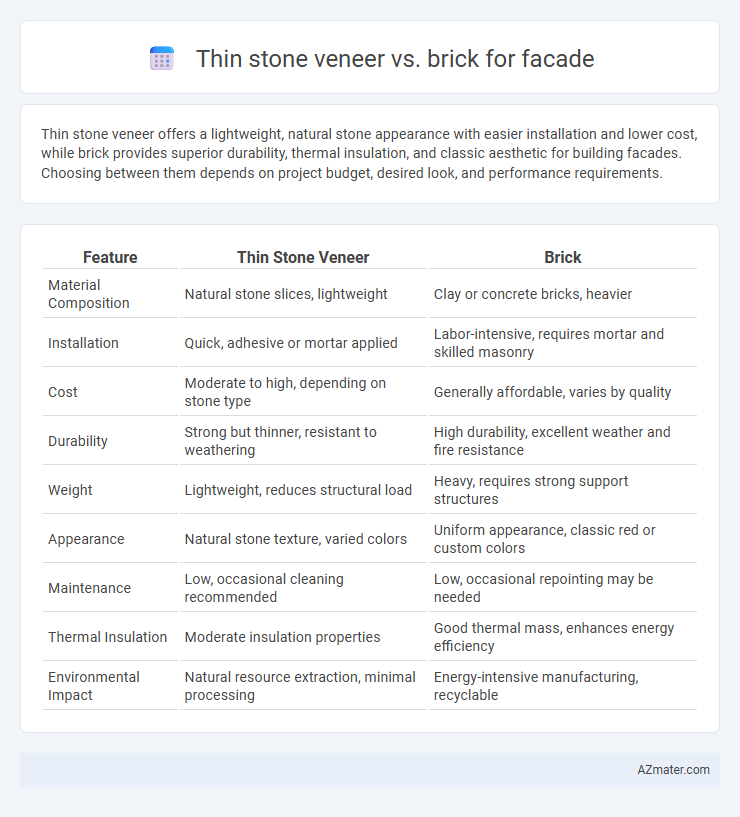Thin stone veneer offers a lightweight, natural stone appearance with easier installation and lower cost, while brick provides superior durability, thermal insulation, and classic aesthetic for building facades. Choosing between them depends on project budget, desired look, and performance requirements.
Table of Comparison
| Feature | Thin Stone Veneer | Brick |
|---|---|---|
| Material Composition | Natural stone slices, lightweight | Clay or concrete bricks, heavier |
| Installation | Quick, adhesive or mortar applied | Labor-intensive, requires mortar and skilled masonry |
| Cost | Moderate to high, depending on stone type | Generally affordable, varies by quality |
| Durability | Strong but thinner, resistant to weathering | High durability, excellent weather and fire resistance |
| Weight | Lightweight, reduces structural load | Heavy, requires strong support structures |
| Appearance | Natural stone texture, varied colors | Uniform appearance, classic red or custom colors |
| Maintenance | Low, occasional cleaning recommended | Low, occasional repointing may be needed |
| Thermal Insulation | Moderate insulation properties | Good thermal mass, enhances energy efficiency |
| Environmental Impact | Natural resource extraction, minimal processing | Energy-intensive manufacturing, recyclable |
Introduction: Choosing the Right Façade Material
Thin stone veneer offers a lightweight, cost-effective alternative to traditional brick for facades, providing natural stone aesthetics without the heavy structure. Brick, known for its durability and classic appeal, delivers excellent thermal insulation and low maintenance over time. Selecting between thin stone veneer and brick depends on factors like budget, structural support, desired appearance, and weather resistance for the building's exterior.
Aesthetic Appeal: Thin Stone Veneer vs Brick
Thin stone veneer offers a natural, textured appearance that mimics full-thickness stone, providing a rustic and elegant facade with greater design versatility compared to traditional brick. Brick facades deliver a classic, timeless look with uniform color and pattern, creating a structured and cohesive aesthetic that complements various architectural styles. The choice between thin stone veneer and brick largely depends on the desired visual impact, with stone veneer emphasizing organic variation and brick ensuring consistent, enduring charm.
Durability and Longevity Comparison
Thin stone veneer offers excellent durability with resistance to weathering, chipping, and fading, maintaining its appearance for decades under proper installation and sealing. Brick facades are renowned for their exceptional longevity, often lasting over a century due to their solid composition and natural resistance to fire, insects, and impact. While thin stone veneer provides a lighter, easier-to-install option with strong durability, brick generally outperforms in long-term structural endurance and maintenance-free lifespan.
Installation Process and Labor Requirements
Thin stone veneer offers a lighter weight and easier handling compared to traditional brick, which significantly reduces installation time and labor intensity for facade projects. Brick installation demands skilled masons to ensure precise mortar application and alignment, resulting in higher labor costs and longer project durations. Thin stone veneer can be installed over various substrates with mechanical fastening or adhesive methods, streamlining the process and minimizing the need for extensive structural support.
Weight and Structural Implications
Thin stone veneer typically weighs between 10 to 15 pounds per square foot, significantly lighter than traditional brick veneer, which can weigh around 35 to 40 pounds per square foot. This reduced weight decreases the structural load on buildings, potentially lowering framing and foundation costs while simplifying installation procedures. Choosing thin stone veneer also minimizes seismic risk in earthquake-prone areas due to its lighter mass compared to heavier brick facades.
Cost Analysis: Initial Investment and Maintenance
Thin stone veneer offers a lower initial investment compared to traditional brick, costing approximately $6 to $9 per square foot, while brick ranges from $12 to $20 per square foot. Maintenance expenses for thin stone veneer are generally minimal, requiring occasional cleaning and resealing, whereas brick may incur higher costs due to repointing and mortar repairs over time. Long-term durability of brick can offset some maintenance costs, but the upfront affordability and ease of installation make thin stone veneer a cost-effective facade option.
Energy Efficiency and Insulation Properties
Thin stone veneer offers superior thermal mass compared to brick, enhancing energy efficiency by maintaining more stable indoor temperatures and reducing heating and cooling demands. Brick provides excellent insulation properties with its dense composition, but may require additional insulation layers to match the overall energy performance of stone veneers. Both materials can contribute to energy-efficient facades, but stone veneer's ability to absorb and slowly release heat often results in better passive temperature regulation.
Environmental Impact and Sustainability
Thin stone veneer offers a lower environmental impact compared to traditional brick due to reduced material extraction and transportation energy, making it a more sustainable facade option. Stone veneer typically requires less energy-intensive manufacturing processes and generates less construction waste, contributing to improved eco-friendliness. Brick, while durable and recyclable, involves high kiln firing emissions and heavier transportation carbon footprints, which can diminish its sustainability profile in facade applications.
Maintenance Needs Over Time
Thin stone veneer requires minimal maintenance, as it is resistant to chipping, cracking, and efflorescence, making it ideal for long-term durability. Brick facades demand regular upkeep, including mortar joint repointing, cleaning, and sealing to prevent moisture infiltration and structural damage. Over time, thin stone veneer generally offers lower repair costs and less frequent maintenance compared to traditional brick exteriors.
Conclusion: Which Material is Best for Your Project?
Thin stone veneer offers a lightweight, cost-effective solution with a natural, textured appearance ideal for enhancing aesthetic appeal without significant structural support. Brick provides superior durability, thermal insulation, and low maintenance, making it a long-lasting choice for projects prioritizing strength and energy efficiency. The best material depends on project goals: choose thin stone veneer for design flexibility and budget constraints, or brick for longevity and enhanced building performance.

Infographic: Thin stone veneer vs Brick for Façade
 azmater.com
azmater.com